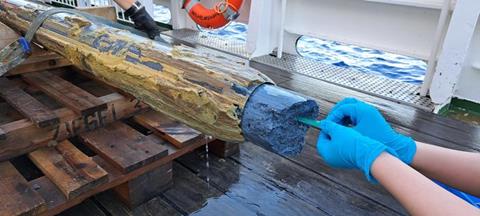Diverse life forms exist on and within the ocean floor. These primarily consist of microbes, tiny organisms that can cope with extreme environmental conditions. These include high pressures and salinities, as well as extreme pH values and a limited supply of nutrients.

A team of researchers has now been able to detect microbial life in two newly discovered mud volcanoes with very high pH values. Their findings have been published in the professional journal Communications Earth & Environment.
READ MORE: Even inactive smokers are densely colonized by microbial communities
READ MORE: Answers to existence of alien life might be found in Earth’s deep-sea volcanoes
In their study, first author Palash Kumawat of the Geosciences Department at the University of Bremen and his colleagues used lipid biomarker analyses to decipher the survival strategies of the microbes in this harsh ecosystem. The high pH value of 12 here is especially challenging for deep-sea life; This is one of the highest known value so far in ecosystems.
Trace analysis
In order to detect life at all, the researchers had to resort to special methods of trace analysis. In this situation, the detection of DNA can be ineffectual where there is a low number of living cells. “But we were able to detect fats,” says first author Palash Kumawat, who is presently a PhD candidate in the Geosciences Department. “With the help of these biomarkers we were able to obtain insights into the survival strategies of methane- and sulfate-metabolizing microbes in this extreme environment.”
Microbial communities metabolize carbon in the deep sea and thereby contribute to the global carbon cycle. However, the communities that the team describe in the publication draws its energy from minerals within rocks and gases such as carbon dioxide and hydrogen to produce methane, for example, an important greenhouse gas. These processes initially take place independently of the ocean above.
The lipids also provide clues to the age of the microorganisms. If the cellular biomolecules are intact, they represent a living or recently dead community. If they are not intact, they are geomolecules, which means that they are fossil communities from the past. According to Kumawat, the combination of isotopes and the lipid biomarkers indicates that multiple microbial communities now live in this inhospitable habitat and have lived there in the past. “This distinction helps us when working in areas with extremely low biomass and nutrient deficiency.”
Life under extreme conditions
Dr. Florence Schubotz, organic geochemist at MARUM – Center for Marine Environmental Sciences at the University of Bremen and co-author of the study, adds: “What is fascinating about these findings is that life under these extreme conditions, such as high pH and low organic carbon concentrations is even possible. Until now, the presence of methane-producing microorganisms in this system has been presumed, but could not be directly confirmed. Furthermore, it is simply exciting to obtain insights into such a microbial habitat because we suspect that primordial life could have originated at precisely such sites.”
The samples for the study come from a sediment core that was retrieved by the Research Vessel Sonne in 2022 during Expedition SO 292/2. Not only were the scientists able to discover the previously unknown mud volcanoes of the Mariana forearc during this cruise, but also to sample them.
The samples were obtained as part of the Cluster of Excellence “The Ocean Floor – Earth’s Uncharted Interface.” Palash Kumawat and his colleagues are now planning to cultivate organisms in an incubator to find out more about their nutrient preferences in inhospitable environments.







No comments yet